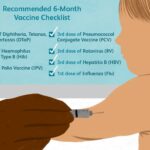A test kit for pregnancy detects the human chorionic gonadotropin (hCG) hormone to confirm pregnancy. These kits offer quick results at home through a urine sample.
Embarking on the journey of parenthood often begins with the use of a pregnancy test kit. These user-friendly devices are designed for expectant individuals to use in the privacy and comfort of their homes, delivering swift and reliable results. Typically, test kits come with simple instructions, where a user applies a few drops of urine onto a chemically prepared test strip or immerses it in urine for a specified duration.
After a short waiting period, the presence or absence of the hCG hormone is revealed, often through a change in color or the appearance of lines on the test area. The ease of accessing these kits at pharmacies and convenience stores makes them a first step for many in confirming pregnancy, thereby eliminating the wait for a doctor’s appointment for initial confirmation. As a cornerstone of early pregnancy detection, these kits empower individuals to make informed decisions about their health and prenatal care promptly.
The Journey To Confirmation
The Journey to Confirmation: a voyage filled with anticipation and hope, draws many to the defining moment that test kits for pregnancy can provide. This journey often begins with subtle signs and leads to the search for clear, reliable confirmation.
First Signs Of Pregnancy
Suspecting a pregnancy sets forth a cascade of emotions and observations. Glimpses of early symptoms send future parents on a quest for knowledge. Common initial indicators include:
- Missed periods: A significant sign often prompts the use of a test kit.
- Unusual fatigue: Persistent exhaustion without clear cause.
- Nausea or morning sickness: Often strikes without warning.
- Breast changes: Tenderness or swelling signals hormonal shifts.
Evidence mounts day by day as anticipation grows. Yet, discerning certainty from these clues requires a reliable method. Enter the world of pregnancy testing.
Seeking Clear Answers
The quest for verification pushes one towards the definitive reliability of a pregnancy test kit. Selecting the right test kit is crucial. Make note of the following features:
| Feature | Description |
|---|---|
| Sensitivity | Measures the minimum hCG levels detectable. |
| Accuracy | Percentage likelihood of correct results. |
| Speed | Time taken to produce results. |
| Ease of Use | Simple instructions and a clear outcome display. |
Follow the test instructions meticulously. Early morning urine generally provides the most accurate results due to its concentrated nature. Lines, colors, or symbols will chart your path on this transformative journey.

Types Of Pregnancy Tests
Discovering pregnancy is a life-changing moment, and choosing the right test is crucial. There are various pregnancy tests available. Knowing the different types can help you pick the one that fits your needs best.
Home Pregnancy Kits
Home pregnancy kits are popular for their ease of use and privacy. These tests measure the level of hCG hormone in your urine. hCG is a hormone present during pregnancy.
- Dipstick tests: Simply dip the test strip into a container of urine.
- Midstream tests: Hold the test in your urine stream.
- Digital tests: Offer a clear readout with the words ‘Pregnant’ or ‘Not Pregnant.’
Most home kits boast 99% accuracy when used correctly. Read the instructions carefully for the best results.
Clinical Blood Tests
Clinical blood tests offer a more detailed look at hCG levels. Doctors perform these tests. There are two main types:
- Qualitative hCG blood test: Confirms pregnancy by simply detecting hCG presence.
- Quantitative hCG blood test: Measures the precise level of hCG. This helps track pregnancy progress.
Blood tests can detect pregnancy earlier than urine tests, sometimes within 6 to 8 days after ovulation. Schedule an appointment with your doctor for conclusive results.
How Home Test Kits Work
Discovering a potential pregnancy can be both exciting and nerve-wracking. Home pregnancy test kits offer a private way to check. These easy-to-use tools have helped millions get quick results. Let’s explore how these remarkable little kits function.
Understanding Hcg Levels
After a fertilized egg attaches to the uterus, the body begins producing hCG. This hormone is the testing target for home pregnancy kits. Levels of hCG double every few days in early pregnancy.
Test kits detect hCG levels through a chemical reaction. A few minutes after introducing a urine sample, the chemical strip reacts. A positive result means hCG is present in significant amounts.
Factors affecting hCG levels include the time of day and fluid intake. For best results, using the first urine of the day is ideal. Always follow the instructions provided with the test kit.
Reading The Results
Knowing how to interpret test results is crucial. Clear instructions guide the process. Home kits typically display results with lines, symbols, or digital readouts.
| Type of Test | Indicator | Result Meaning |
|---|---|---|
| Line Test | One or Two Lines | Single Line (Not pregnant), Double Line (Pregnant) |
| Symbol Test | Plus or Minus | Plus (Pregnant), Minus (Not pregnant) |
| Digital Test | Words “Pregnant” or “Not Pregnant” | Self-explanatory readout |
Test accuracy varies based on timing and proper usage. Tests perform best when used after a missed period. For confirmed results, a follow-up with a healthcare provider is advisable.
Remember, no test is flawless. False positives and negatives can occur. Repeating the test in a week or consulting a doctor is wise if results are unclear or unexpected.
Factors Affecting Test Accuracy
Wondering about the accuracy of your pregnancy test? Several factors can influence the results. Understand these and you’ll be more confident in reading the test’s outcome.
Timing Of The Test
Knowing when to take a pregnancy test is crucial.
Tests detect the hormone hCG. It increases after implantation. Take the test too early, and hCG might be too low to detect. Most tests recommend waiting until after a missed period. This usually means waiting at least two weeks from the time of conception. For the most reliable result, taking the test one week after a missed period is best.
Following Instructions Precisely
Every step matters when you’re taking a pregnancy test.
Pregnancy test kits come with instructions. It’s important to follow them exactly. This ensures accuracy. Missteps can lead to false readings. Steps to consider carefully include:
- Preparing the test: Avoid touching the test strip.
- Timing: Watch the clock and read the results within the time frame given.
- Storing the kit: Keep it in a suitable environment, away from moisture and sunlight.
Stick closely to the provided guidance. Doing so will greatly reduce the chance of an inaccurate result.
Common Pitfalls And Errors
Using a pregnancy test kit seems straightforward, but mistakes can happen. Imagine waiting eagerly for the right result, only to be misled. It’s crucial to know what can go wrong. This helps you get accurate results. Below, let’s discuss common errors and how to avoid them.
Avoiding False Positives
False positives are rare but distressing. They happen when a test says you’re pregnant when you’re not. Follow these tips:
- Check the expiration date. Expired tests can give wrong results.
- Read instructions carefully. Each kit differs slightly.
- Follow the time recommendations for reading the test. Looking at the result too soon or too late can mislead you.
Medications can also interfere. For example, fertility drugs containing hCG might cause a false positive. If you’re on medication, consult your doctor first.
Beware Of False Negatives
False negatives can cause unnecessary anxiety. Avoid them with these steps:
- Test at the right time. Too early, and hCG levels might be too low.
- Use the first-morning urine. It has the highest hCG concentration.
- Ensure the test is sensitive enough. Some kits detect lower levels of hCG.
Drinking too much liquid before the test can dilute your urine. This can lead to a false negative. Limit fluids before testing.
Choosing The Right Test Kit
Expecting a baby is a pivotal period in life. Choosing the right pregnancy test can help confirm this exciting news. With several options available, it’s crucial to pick a reliable kit for accurate results. This post outlines important features to consider and recommends trusted brands.
Features To Consider
Accuracy, ease of use, and speed of results are vital features in a pregnancy test kit:
- Sensitivity: Measures hCG levels detectable.
- Readability: Digital tests display clear results.
- Result Time: Some kits offer faster readings.
- Test Time: Check when to use the test for best results.
Digital tests are a popular choice thanks to their straightforward ‘Pregnant’ or ‘Not Pregnant’ display.
Recommended Brands And Types
The following table showcases top pregnancy test kits:
| Brand | Type | Sensitivity | Result Time | User Rating |
|---|---|---|---|---|
| First Response Early Result | Manual | 6 days sooner | 3 minutes | 9/10 |
| Clearblue Digital | Digital | 5 days sooner | 1-3 minutes | 9.5/10 |
First Response Early Result and Clearblue Digital lead the market. They promise high sensitivity and clear instructions, which make the testing process stress-free. Remember to check the expiration date before purchasing.
When To Consult A Healthcare Provider
Finding out you might be pregnant can bring a mix of emotions. Knowing when to reach out to a healthcare provider is crucial. Both for guidance and for the health of you and your potential baby. Whether results seem unclear or firmly positive, understanding when to seek medical advice is essential. Let’s explore these situations.
Interpreting Ambiguous Results
If a pregnancy test doesn’t give a clear answer, it’s time to talk to a doctor. Here’s when medical advice can help:
- Unclear lines: Sometimes, test lines are faint or confusing. A doctor can clarify.
- Expired tests: Out-of-date tests may not work right. A healthcare provider can do a fresh test.
- Different results: If multiple tests disagree, a professional can give a definitive answer.
Contact your doctor if any of these occur. They can offer the most accurate test and advice.
Next Steps After A Positive Test
A positive pregnancy test is a life-altering moment that warrants professional insight.
- Confirm the result: A healthcare provider will confirm the test with more checks.
- Discuss health history: Tell your doctor about any medical conditions or past pregnancies.
- Plan your care: A provider will create a plan with you for a healthy pregnancy.
After a positive test, contacting your doctor should be a priority. They will guide you on the journey ahead.
Emotional Aspects Of Testing
Discovering potential pregnancy can stir a whirlwind of emotions. From the moment a test kit is picked up, individuals often travel through a spectrum of feelings. Behind the simplicity of a pregnancy test, lies a deeply personal experience. Each test holds the possibility of life-changing news, prompting a complex mix of excitement, worry, hope, and fear.
Managing Anxiety And Excitement
The balance between anxiety and excitement is a delicate one. Waiting for those decisive lines to appear can seem endless, transforming seconds into minutes, and minutes into hours. It’s a time when emotions don’t just sit quietly; they dance, they twist, they turn. One way to manage these feelings is through healthy distractions such as:
- Deep breathing exercises
- A short walk outside
- Listening to soothing music
Keeping a small diary or a note app handy to jot down thoughts and feelings can also help in navigating this emotional tide. Remember, these feelings are natural and acknowledging them is the first step to dealing with them effectively.
Support For All Outcomes
No outcome is ideal for everyone. A positive result may bring joy for some and uncertainty for others. A negative result can provide relief, or perhaps disappointment. In any case, having a network of support is crucial. Be it family, friends, or professional services, no one should navigate this journey alone. Here’s how to secure support:
- Identify someone to be with during the test.
- Have a plan for both possible outcomes beforehand.
- Know the local resources and support groups available.
Seeking professional advice is also a wise move. Doctors, counselors, and support lines can offer the essential care needed, no matter the test result.
Whichever way the journey sways, kindness to oneself is key. Allow time for processing emotions and making informed decisions. Acknowledge the courage it takes to embark on this path.
Advances In Pregnancy Testing
Discovering pregnancy is a moment full of emotions. Over time, test kits have evolved. These days, tests are faster, more accurate, and easier to use. Let’s delve into recent innovations that are making waves in the world of pregnancy testing.
Digital Innovations
Digital pregnancy tests have revolutionized home testing. Unlike traditional tests, digital versions spell out results clearly, reducing confusion. Features include:
- Clear digital display showing “Pregnant” or “Not Pregnant”
- Smart countdown timers indicating when to read the result
- Smartphone connectivity for app-based result tracking
- Estimates of how far along the pregnancy is
These enhancements improve the usability of pregnancy tests, making a significant impact on user experience. They remove the guesswork from interpreting lines or colors.
Forthcoming Developments
Research into pregnancy testing does not stand still. The next generation of tests includes incredible features:
| Development | Description |
|---|---|
| Health Tracking | Integration with health apps to provide wide-ranging wellness advice. |
| Early Detection | Tests sensitive enough to detect pregnancy earlier than ever before. |
| Eco-Friendly Options | Sustainable materials to reduce waste and environmental impact. |
This is just the beginning. As technology improves, pregnancy tests will become even smarter. People can expect tests that offer more information and support throughout early pregnancy. Such advancements ensure that the journey to becoming a parent is filled with joy and certainty.

Credit: www.health-metric.com
Frequently Asked Questions On Test Kit For Pregnancy
How Accurate Are Home Pregnancy Tests?
Home pregnancy tests are generally very accurate when used correctly. Their accuracy rate is about 99% if you test on the day of your missed period. However, variables such as testing too early or improper use can affect accuracy.
What Types Of Pregnancy Tests Are Available?
There are two main types of pregnancy tests: urine tests and blood tests. Urine tests can be done at home or in a doctor’s office, while blood tests must be done in a clinic. Both detect the hormone hCG to confirm pregnancy.
When To Take A Pregnancy Test For Best Results?
The best time to take a pregnancy test is after missing your period. Testing one week after a missed period will improve accuracy. Early tests are available but are less reliable and are best used a few days before the expected period.
Can Medications Affect Pregnancy Test Results?
Some medications can affect the results of a pregnancy test, potentially causing false positives or negatives. HCG injection used in fertility treatments is a common cause. Always read the test’s instructions and consult with your healthcare provider for clarification.
Conclusion
Navigating the journey to parenthood can be thrilling yet nerve-wracking. A reliable pregnancy test kit offers the first glimpse into your potential future as a parent. Remember, selecting the right test kit is crucial for accurate results. Trust in your choice, and take that first step with confidence. Good luck on your path to discovering your joyous news!









